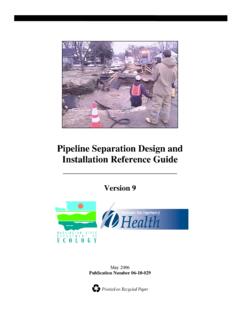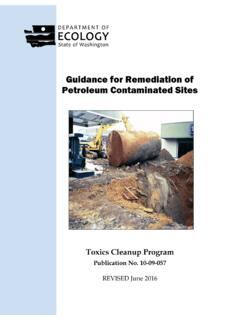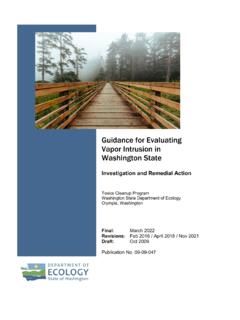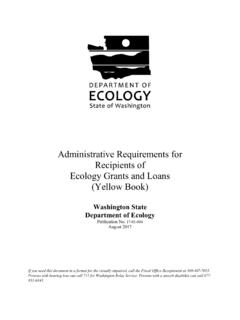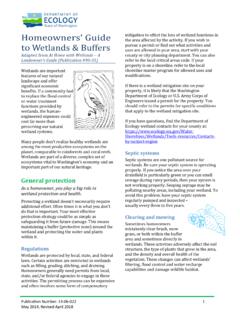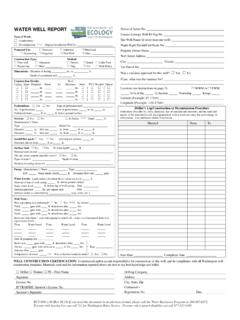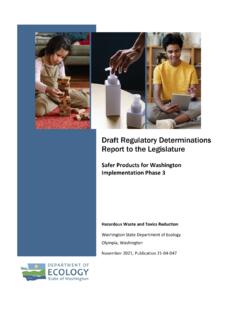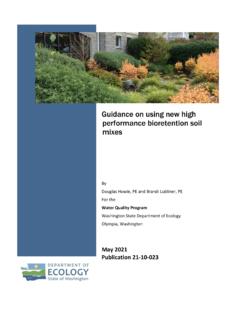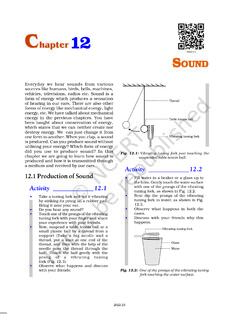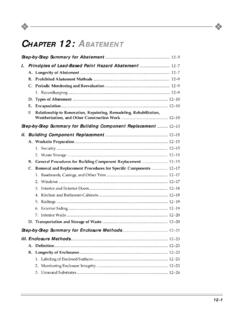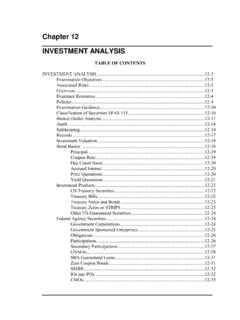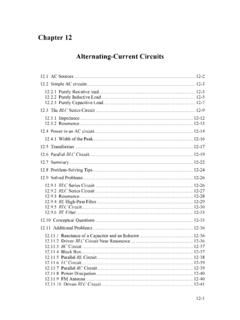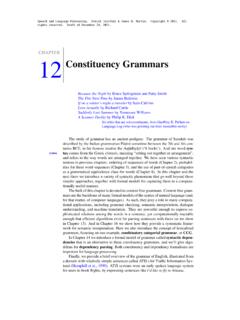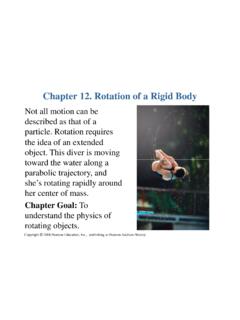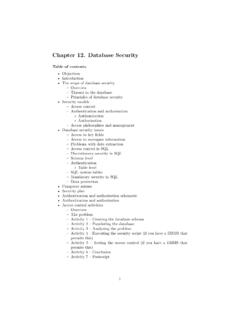Transcription of Chapter 12 Piers, Docks and Overwater Structures
1 SMP Handbook Publication Number: 11-06-010 1/11; rev. 6/17 Chapter 12 Piers, Docks and Overwater Structures Phase 3, Task Shoreline Master Program Planning Process Introduction Piers, Docks and other Overwater and in-water Structures are significant components of our shorelines. They play a major role in commerce at ports and provide recreational opportunities at parks. Piers, Docks and swimming floats are common at single family and multi- family residences on the shoreline, particularly on lakes and marine bays. While these Structures are important for commerce and recreation, they also can have impacts on the shoreline ecology, aesthetics and navigation. Shoreline Master Programs should include policies and regulations regarding piers, Docks and other Overwater and in-water Structures . SMPs will not be adequate if they only refer to and rely on state and federal agency documents, such as the Army Corps of Engineers Regional General Permits. Figure 12-1: Piers, Docks , and boat launches come in various shapes and sizes to provide access to the water.
2 (Photos: Upper left, Washington Coastal Atlas; upper right, Hugh Shipman; bottom, City of Kirkland.) SMP Handbook Chapter 12 2 Publication Number 11-06-010 1/11; rev. 6/17 The shoreline inventory and characterization should inform where Overwater Structures such as piers and Docks may be allowed. Portions of the shoreline may not be appropriate for these Overwater Structures due to impacts to shoreline ecological functions, navigation and aesthetics. In some areas, water levels are low, so moorage facilities need to be very long to reach adequate depth for boats. In other areas, wave and wind action will damage or destroy moorage facilities. This guidance focuses on the Overwater Structures discussed below. The SMP Guidelines address boating facilities including marinas, but exclude Docks serving four or fewer single family residences from boating facilities.
3 SMPs should define how many moorage facilities constitute a marina. Floating homes, also known as houseboats, are residences built on floats. The SMP Guidelines prohibit new Overwater residences including floating homes but allow improvements associated with life safety matters and property rights [WAC 173-26-241(3)(j)]. The SMA classifies floating homes that were permitted or legally established prior to January 1, 2011 as a conforming preferred us. SMP regulations pertaining to floating homes cannot effectively preclude maintenance, repair, replacement and remodeling [RCW (5)]. Floating homes are not addressed here. Descriptions of Overwater Structures A common understanding of these Overwater and in-water Structures will be helpful. Here are Ecology s descriptions of these Structures . We will often refer to moorage facilities or piers and Docks in this document as a general term that covers most or all of these Structures . Piers and Docks adjoin the shoreline, extend over the water, and serve as a landing or moorage place for commercial, industrial and pleasure watercraft.
4 O Piers are built on fixed platforms and sit above the water. o Docks are anchored to the land, substrate or the pier with pilings or anchors and float on the water. Gangways are walkways that connect the pier to the dock. Gangways are often used in areas where the water level changes due to tides or seasonal variations. Ells are extensions of piers, often in a U-shape or L shape, that provide additional watercraft moorage. Recreational floats are platforms that float on the water s surface. They are anchored off-shore and are used for swimming and fishing. Some floats have components such as slides and trampolines. Boat houses (Figure 12-2) basically serve as garages for boats. They have walls and a roof, and are situated on the water or just above the water s edge. SMP Handbook Chapter 12 3 Publication Number 11-06-010 1/11; rev. 6/17 Mooring buoys typically include an anchoring system with an anchor and anchor line, a float marking its location, and a fitting for a vessel s mooring chain or hawser.
5 Washington laws establish two categories for mooring buoys -- commercial and recreational [RCW ]. Commercial buoys are typically used for temporary moorage of a vessel that is awaiting transit or loading or offloading. Recreational buoys are used as semi-permanent moorage for recreational vessels. Mooring piles or pilings are fixed poles or groups of poles set in the substrate and extending above the water line. Lifts or boat lifts raise watercraft out of the water for launching or storing. They may be attached to the substrate, a pier or dock, bulkhead or float or be located upland. Canopies are covers that protect watercraft from the sun and rain. Boat or launch ramps are solid or relatively solid surfaces that bridge land and water and are used for moving watercraft into and out of the water. Railways are rails attached to the substrate used for launching and retrieving watercraft, usually with a cradle and winch system. Others such as jet ski floats and boat dry Docks provide storage of watercraft out of the water.
6 Some floats serve as helicopter pads, while others are used for docking seaplanes. SMP Guidelines The SMP Guidelines address shoreline modifications including piers and Docks , shoreline stabilization, breakwaters and others [WAC 173-26-231]. SMPs shall implement the following principles for all shoreline modifications: Allow structural shoreline modifications only where necessary to support or protect an allowed primary structure or legally existing shoreline use. WAC 173-26-231(3)(b): ..Pier and dock construction shall be restricted to the minimum size necessary to meet the needs of the proposed water-dependent use. Water-related and water-enjoyment uses may be allowed as part of mixed-use development on over-water Structures where they are clearly auxiliary to and in support of water-dependent uses, provided the minimum size requirement needed to meet the water-dependent use is not Figure 12-2: A boat house on Whidbey Island shelters the boat from the weather.
7 (Photo by Betty Renkor.) SMP Handbook Chapter 12 4 Publication Number 11-06-010 1/11; rev. 6/17 Reduce adverse effects of and limit shoreline modifications in number and extent. Allow only modifications appropriate to the type of shoreline and environmental conditions for which they are proposed. Assure that shoreline modifications individually and cumulatively do not result in a net loss of ecological functions. Base SMP provisions on scientific and technical information and a comprehensive analysis of drift cells or reach conditions. Plan to enhance impaired ecological functions while accommodating permitted uses. WAC 173-26-231(3)(b) direct that new piers and Docks be allowed only for water-dependent uses or public access. A pier or dock associated with a single-family residence that provides access to watercraft is a water-dependent use. Applicants must demonstrate that a specific need exists for new pier or dock construction to support water-dependent uses, except for those that are accessory to single-family residences.
8 For residential development, SMPs should require two or more dwellings provide joint use or community dock facilities when feasible, rather than allow individual Docks for each residence. Joint use Docks will have reduced impacts to the shoreline environment Figure 12-3: The 300-foot pier at Kayak Point County Park in Snohomish County provides opportunities for fishing and crabbing. (Photo by Hugh Shipman.) SMP Handbook Chapter 12 5 Publication Number 11-06-010 1/11; rev. 6/17 and navigation compared with individual Docks and result in shared costs for the owners. For port districts, commercial or public entities with water-dependent uses, a needs analysis or master plan that projects future needs for pier or dock space and is approved by the local government and consistent with the SMP Guidelines may satisfy the demonstration requirement. All piers and Docks must be built to avoid, or if that is not possible, minimize and mitigate impacts to ecological processes and functions and critical areas resources.
9 This requirement also would apply to other Overwater Structures described above. Impacts of Overwater Structures About 5,500 piers and Docks exist in the marine waters of Washington State (DNR, 2009). Overwater Structures such as piers and Docks , boat houses and others can have adverse impacts on the environment, navigation and aesthetics. This section provides a brief review of impacts that should be considered as you determine whether and where to allow these Structures on your shoreline. Environmental impacts Overwater Structures can have impacts on various factors that control habitats. These include light, wave energy, substrates and water quality. Except as noted, the impacts summarized in this section and the recommendations are from Overwater Structures : Marine Issues (Nightingale and Simenstad, 2001) and Over-Water Structures : Freshwater Issues (Carrasquero, 2001). Changes to light affect the behavior of salmon. Salmon fry have been seen avoiding travel under Docks and piers during daylight hours.
10 As they move away from the shore, they become subject to attack by larger predators that typically stay in deeper waters. The amount of light also affects salmon feeding with less light, they eat less. Figure 4: A pier in Tramp Harbor, Vashon Island, casts a shadow on the water. (Photo by Hugh Shipman.) SMP Handbook Chapter 12 6 Publication Number 11-06-010 1/11; rev. 6/17 With less light, there are fewer small species that salmon eat. Food is less available. Reductions in light affect the growth of sea grasses such as eelgrass, which provides a rich feeding area for marine birds and fish, and offers shelter to species such as Dungeness crab, salmon and herring. Changes to the substrate result from pile driving and the presence of piles. Pile driving rearranges the distribution of sediments, resulting in changes to the substrate bathymetry of the water body. Pilings take up space, reducing habitat; cast shade, affecting light; catch floating debris, affecting light and habitat.


